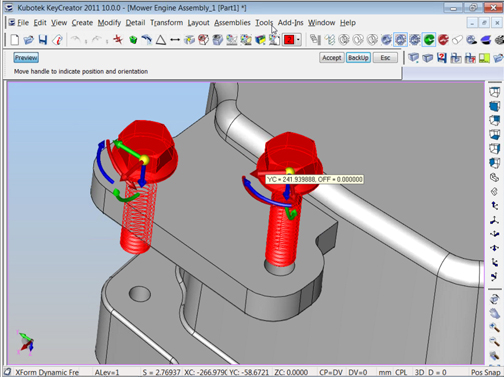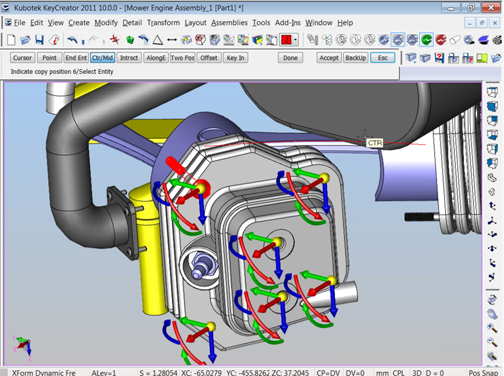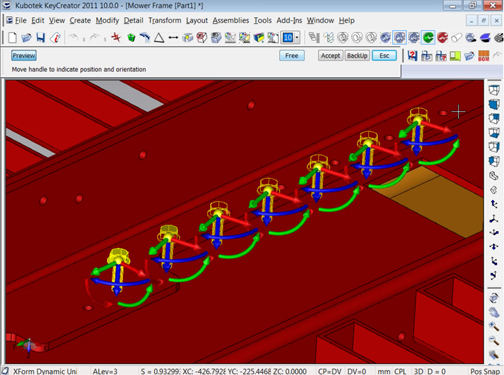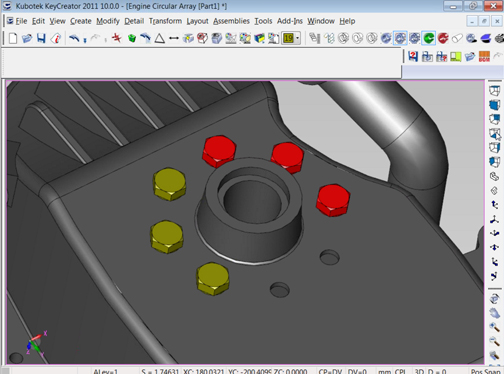March 8, 2011


Kubotek‘s KeyCreator (previous CADKEY), credited with being a pioneer in direct editing, never really left the 3D mechanical modeling scene. But new kids on the block have been hogging the blogs so much that, at times, KeyCreator seems to be on the sideline. Perhaps, secure with a core group of loyal customers, KeyCreator never felt the pressure to stir the pot and rock the boat.
This February, the software returns as KeyCreator 2011, with 64-bit performance gain and more dynamic editing.
In previous releases, KeyCreator preserved much of its original interface, which relies on menu options and overhead text prompts. In contrast, subsequent direct modelers like SpaceClaim, Autodesk Inventor Fusion, and Siemens PLM Software’s NX and Solid Edge with Synchronous Technology let you directly manipulate your geometry: pick a face and you’ll be given the options to push, pull, or rotate it via control arrows; pick an edge and you’ll be prompted with a series of options to blend or chamfer the corner; pick a hole or a boss and you’ll be prompted with the options to resize it or move it along an axis; and so on. This makes KeyCreator’s younger rivals seem—for the lack of a better term—more direct.
In Release 2011, KeyCreator still retains its menus and overhead prompts, but it also adds much more dynamic editing functions: the ability to push, pull, and rotate faces on your solid models. KeyCreator’s Dyna-Handle, you’ll notice, works in the same fashion as the move-rotate control handles found in SpaceClaim, Inventor Fusion, and Synchronous Technology. One of KeyCreator’s original inventions—resizing solids and features by editing their displayed dimensions—remains intact. Coupled with the newly added push-pull modeling functions, it gives you easier ways to create and edit geometry.
Two new commands debuting in this release—Dynamic Free Array and Dynamic Linear Array—let you quickly place identical parts in specific locations. Free array allows you to select an item (for instance, a screw or a bracket), then select the positions where you’d like to see the same item duplicated, and execute the command. Dynamic Linear Array lets you select a single item (or several), then create a series of duplicates in a structured pattern (for instance, along a straight line or an arc). You can treat the entire series like a patterned feature, snapping them into place along an axis or an angle. Though the initial group you create with the Dynamic Linear Array command moves in unison, you may also isolate any individual item to manage its placement independently. The previews you get before executing the command gives you a clear idea what the results will look like.
Like many other direct modelers, KeyCreator gives you a flexible way to reshape imported geometry without the confines and limits of a history-based, parametric modeling program. It reads a number of 3D formats, including STEP, IGES, ACIS, Parasolid, Autodesk Inventor, and DWG/DXF.
Along with the features mentioned above, KeyCreator comes with a wealth of visual display options, drawing creation tools, surfacing tools, and assembly mating tools. One notable command in its assembly environment is Transform Dynamic, which lets you rotate or reposition certain sub-assemblies without worrying about the mating conditions applied to internal components. For example, if you rotate a gasket, the rings nested to its holes (in other words, mated to the holes at the center-points) will realign themselves to the new position.
The interface improvements—particularly, the adoption of push-pull handles—are expected to reduce the learning curve. You can still see remnants of the modeling methods many have done away with: for example, the requirement to click Accept to confirm or validate some simple operations, or the need to select an operation from a drop-down menu before clicking on the geometry to execute the command. (Francis Traylor, a KeyCreator reseller, points out that, if you turn preselect “on” as your normal setup, you can select geometry first, then execute the command you want. See his observations in the comments below.) Nevertheless, the latest release contains enough proof to convince me that Kubotek has launched what I think is KeyCreator’s rejuvenation process. The question is, will the transformation be fast-paced enough to challenge its rivals with a head-start?
For more, watch Kubotek’s demonstration videos, available at KeyCreator 2011’s launch site.
Note: I wrote this blog post based on a WebEx demonstration of the software. I have not personally tested it yet.


Subscribe to our FREE magazine, FREE email newsletters or both!
About the Author
Kenneth Wong is Digital Engineering’s resident blogger and senior editor. Email him at [email protected] or share your thoughts on this article at digitaleng.news/facebook.
Follow DERelated Topics






